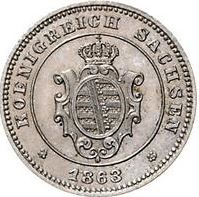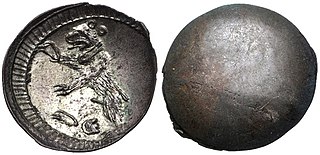
The 'pfennig' or penny is a former German coin or note, which was the official currency from the 9th century until the introduction of the euro in 2002. While a valuable coin during the Middle Ages, it lost its value through the years and was the minor coin of the Mark currencies in the German Reich, West and East Germany, and the reunified Germany until the introduction of the euro. Pfennig was also the name of the subunit of the Danzig mark (1922–1923) and the Danzig gulden (1923–1939) in the Free City of Danzig.

Groschen a name for various coins, especially a silver coin used in various states of the Holy Roman Empire and other parts of Europe. The word is borrowed from the late Latin description of a tornose, a grossus denarius Turnosus, in English the "thick denarius of Tours". Groschen was frequently abbreviated in old documents to gl, whereby the second letter was not an l, but an abbreviation symbol; later it was written as Gr or g.

The Neugroschen was a Saxon Scheidemünze coin minted from 1841 to 1873 which had the inscription Neugroschen. This groschen, made of billon, was equivalent to the Prussian groschen but, unlike the latter, was divided not into 12, but into 10 pfennigs.
The Weißpfennig was a form of silver groschen that was circulated in the Holy Roman Empire in the Late Middle Ages. It was also known as an albus or a Rhenish groschen. It was minted from the second half of the 14th century onwards in the Lower Rhine region by the four Rhenish electors of the Holy Roman Empire, who set up a joint mint in 1385–86. It was intended for everyday use, whilst the gold Rhenish gulden of the same era was intended as a trade coin. Those minted in Mainz were inscribed on one side 'Mainzer Rad' and were also known as Raderalbus.

The Tympf was a low-grade silver coin used in Poland-Lithuania, Brandenburg-Prussia, and Russia in the 17th and 18th centuries.

The history of Saxon coinage or Meissen-Saxon coinage comprises three major periods: the high medieval regional pfennig period, the late medieval pfennig period and the thaler period, which ended with the introduction of the mark in 1871/72. Rich silver deposits, which were discovered near Freiberg after the middle of the 12th century, helped Saxony to a leading position in German coinage.

A Schüsselpfennig, also Gehulchter Pfennig is so called due to the stamping technique which results in a concave, one-sided type of Pfennig coin. It was probably first minted in 1374 in the Palatinate. Small Schüsselpfennigs that had entered the Electorate of Saxony were referred to there as Näpfchenheller.
The Weckeler, also called a Weckelerpfennig, is a one-sided silver Palatine pfennig coin of the 14th and 15th century, which was also called the Wegkpfennig in the local dialect. It occurs both as a Schüsselpfennig and as a non-domed, planar coin. The pfennigs were given their contemporary name after their image, a lozenged coat of arms.

The Meissen groschen or broad groschen was a Meissen-Saxon silver coin of the 14th and 15th centuries and the regional currency of the Margraviate of Meissen in the Late Middle Ages. It was introduced by Margrave Frederick II of Meissen in 1338/39 and modelled on the Prague groschen.
The regional pfennig was a type of pfennig, a low denomination coin used in the Holy Roman Empire that began to appear in the 10th century after the period of the supra-regional pfennigs following the coin reform of the Emperor Charlemagne of Francia. With the increasing allocation of royal minting rights under the Münzregal to other mints, different types of pfennig emerged. The mints with their own minting rights included those cities that had attained a special degree of independence, in some cases even imperial immediacy. However, a localization of coinage was partly counteracted by a move by cities to form minting associations or Münzvereins, in which minting agreement standards for the weight and, above all, the fineness of coins were set. which must not be undercut in order to ensure unrestricted convertibility of the coins within the contract area. In later centuries, larger denominations of higher value were introduced, such as the groschen (grossus) and, in the Alpine region, the Kreuzer. The pfennig thus fell from being a major coin and currency money to a small Scheidemünze coin. Attempts at standardisation concentrated on the new, larger denominations and no longer on the pfennig, which basically remained a state coin of only regional significance. In Germany, the pfennig was only successfully unified again in the 19th century, initially through the Prussian small coinage reform of 1821 for the various small coins in the Prussian provinces, and then through the second Imperial Coin Act of 1873.

The Sachsenpfennig, sometimes called the Wendenpfennig or the Hochrandpfennig was a well-known coin of the pfennig type minted in the eastern part of the Stem Duchy of Saxony during the 10th and 11th centuries. It had an upturned perimeter and, next to the Otto Adelheid Pfennig was the most common pfennig type of its time. Sachsenpfennigs are the oldest coins minted in Saxony. Its different names represent a lack of clarity within mediaeval numismatics about the coin.
The Meissen gulden, abbreviation Mfl., was a Rhenish Gold Gulden that was established in Saxony in 1490 at a value of 21 groschen and which, from 1542 to 1838 became a coin of account of the same value.

Mintmaster marks are often the initials of the mintmaster of a mint or small symbols for example at the size of the letters on a coin inscription to denote the coins made under his direction. With his mark, the mintmaster assumed responsibility for ensuing the coins issued by his mint were in accordance with the regulations. Mintmaster marks were used as early as the time of bracteate coinage in the Holy Roman Empire, but these can only rarely be deciphered. All mintmaster marks since the beginning of the minting of Thalers have been identified.

The Hessian Schildgroschen was a coin of the groschen type, based on the Meissen-Saxon Schildgroschen, one of the late medieval, Groschen period coins that was very similar to the Meissen Schildgroschen. It was also called the Kronichte Groschen and Zweischildgroschen.
A Münzfuß is an historical term, used especially in the Holy Roman Empire, for an official minting or coinage standard that determines how many coins of a given type were to be struck from a specified unit of weight of precious metal. The Münzfuß, or Fuß ("foot") for short in numismatics, determined a coin's fineness, i.e. how much of a precious metal it would contain. Mintmaster Julian Eberhard Volckmar Claus defined the standard in his 1753 work, Kurzgefaßte Anleitung zum Probieren und Münzen, as follows: "The appropriate proportion of metals and the weight of the coin, measured according to their internal and external worth, or determined according to their quality, additives and fineness, number and weight, is called the Münzfuß."

The Guter Groschen, also Gutergroschen or Gutegroschen, abbreviation Ggr., is name of the groschen coin that was valued at 1⁄24 of a Reichsthaler from the end of the 16th century. It was called a "good groschen" to distinguish it from the lighter Mariengroschen, which was only valued at 1⁄36 Reichsthaler. The term Guter Groschen remained common until the middle of the 19th century.
A Großpfennig or Großer Pfennig was a Pomeranian pfennig coin of the 14th and 15th centuries. It also referred, in a more general sense, to any coin whose value was a multiple of the pfennig.

From the Late Middle Ages the albus was a common currency in parts of the Holy Roman Empire, especially in the Rhineland. The name albus is Latin and means "white". Because of its higher silver content, this lighter coin differed in colour from the other inferior coins. This resulted in the names denarius albus, Weißpfennig or Rhenish groschen.
The Andreas Hofer Kreuzer, also called the Hofer Kreuzer or Sandwirtszwanziger, was the name of the 20- and 1-kreuzer coins that were minted during the Tyrolean Rebellion in Hall in Tirol in 1809. The obverse depicts the Tyrolean Eagle and the inscription Gefürstete Grafschaft Tirol; the reverse shows the nominal value.

The Ewiger Pfennig or eternal penny was a coin of the regional pfennig period, which was minted until the late medieval groschen time. These coins are mostly of the Hohlpfennig or "hollow pfennig" type which, unlike bracteates, had to be exchanged regularly for a fee but were not subject to annual recall of coins in circulation, the Münzverruf.












